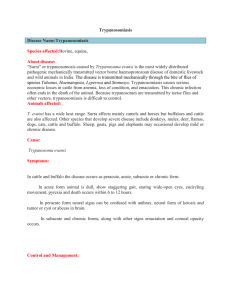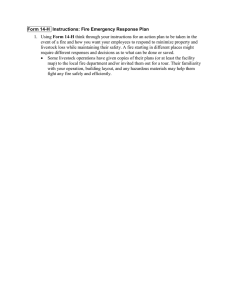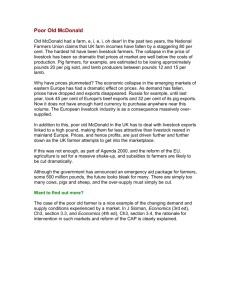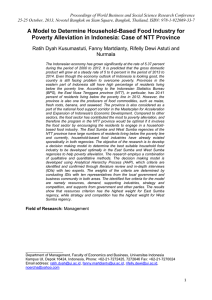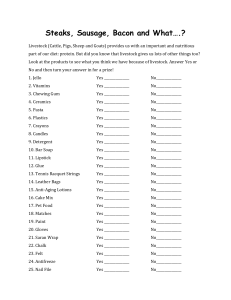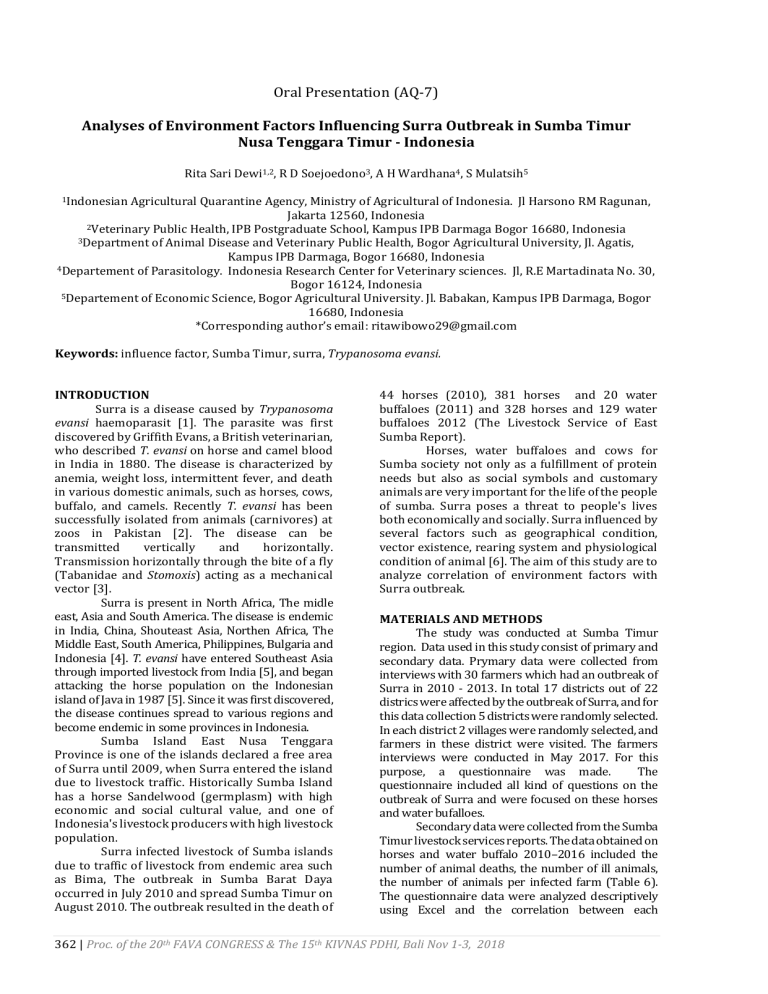
Oral Presentation (AQ-7) Analyses of Environment Factors Influencing Surra Outbreak in Sumba Timur Nusa Tenggara Timur - Indonesia Rita Sari Dewi1,2, R D Soejoedono3, A H Wardhana4, S Mulatsih5 1Indonesian Agricultural Quarantine Agency, Ministry of Agricultural of Indonesia. Jl Harsono RM Ragunan, Jakarta 12560, Indonesia 2Veterinary Public Health, IPB Postgraduate School, Kampus IPB Darmaga Bogor 16680, Indonesia 3Department of Animal Disease and Veterinary Public Health, Bogor Agricultural University, Jl. Agatis, Kampus IPB Darmaga, Bogor 16680, Indonesia 4Departement of Parasitology. Indonesia Research Center for Veterinary sciences. Jl, R.E Martadinata No. 30, Bogor 16124, Indonesia 5Departement of Economic Science, Bogor Agricultural University. Jl. Babakan, Kampus IPB Darmaga, Bogor 16680, Indonesia *Corresponding author’s email: ritawibowo29@gmail.com Keywords: influence factor, Sumba Timur, surra, Trypanosoma evansi. INTRODUCTION Surra is a disease caused by Trypanosoma evansi haemoparasit [1]. The parasite was first discovered by Griffith Evans, a British veterinarian, who described T. evansi on horse and camel blood in India in 1880. The disease is characterized by anemia, weight loss, intermittent fever, and death in various domestic animals, such as horses, cows, buffalo, and camels. Recently T. evansi has been successfully isolated from animals (carnivores) at zoos in Pakistan [2]. The disease can be transmitted vertically and horizontally. Transmission horizontally through the bite of a fly (Tabanidae and Stomoxis) acting as a mechanical vector [3]. Surra is present in North Africa, The midle east, Asia and South America. The disease is endemic in India, China, Shouteast Asia, Northen Africa, The Middle East, South America, Philippines, Bulgaria and Indonesia [4]. T. evansi have entered Southeast Asia through imported livestock from India [5], and began attacking the horse population on the Indonesian island of Java in 1987 [5]. Since it was first discovered, the disease continues spread to various regions and become endemic in some provinces in Indonesia. Sumba Island East Nusa Tenggara Province is one of the islands declared a free area of Surra until 2009, when Surra entered the island due to livestock traffic. Historically Sumba Island has a horse Sandelwood (germplasm) with high economic and social cultural value, and one of Indonesia's livestock producers with high livestock population. Surra infected livestock of Sumba islands due to traffic of livestock from endemic area such as Bima, The outbreak in Sumba Barat Daya occurred in July 2010 and spread Sumba Timur on August 2010. The outbreak resulted in the death of 44 horses (2010), 381 horses and 20 water buffaloes (2011) and 328 horses and 129 water buffaloes 2012 (The Livestock Service of East Sumba Report). Horses, water buffaloes and cows for Sumba society not only as a fulfillment of protein needs but also as social symbols and customary animals are very important for the life of the people of sumba. Surra poses a threat to people's lives both economically and socially. Surra influenced by several factors such as geographical condition, vector existence, rearing system and physiological condition of animal [6]. The aim of this study are to analyze correlation of environment factors with Surra outbreak. MATERIALS AND METHODS The study was conducted at Sumba Timur region. Data used in this study consist of primary and secondary data. Prymary data were collected from interviews with 30 farmers which had an outbreak of Surra in 2010 - 2013. In total 17 districts out of 22 districs were affected by the outbreak of Surra, and for this data collection 5 districts were randomly selected. In each district 2 villages were randomly selected, and farmers in these district were visited. The farmers interviews were conducted in May 2017. For this purpose, a questionnaire was made. The questionnaire included all kind of questions on the outbreak of Surra and were focused on these horses and water bufalloes. Secondary data were collected from the Sumba Timur livestock services reports. The data obtained on horses and water buffalo 2010–2016 included the number of animal deaths, the number of ill animals, the number of animals per infected farm (Table 6). The questionnaire data were analyzed descriptively using Excel and the correlation between each 362 | Proc. of the 20th FAVA CONGRESS & The 15th KIVNAS PDHI, Bali Nov 1-3, 2018 influences factor were tested with Pearson and Spearman correlation test (SPSS 16). The assessment of farmers knowledge on Surra by distributing questionnaires to respondents. The questionnaire was scored. The total score the right answer are 192. Good for > 75% from the total score, enough for ≥50% -≤75%, and poor for <50%. RESULT AND DISCUSSION Farmers Profile The Government program to control Surra involves the community, such as farmers (owner) so that the program can run effectively. Information about educational background and knowledge of the farmers will support the success of Surra control. The results of the study, shows that most respondents were elementary education (63%), senior high school (27%), and university level are 6.7%. The respondent ages 31-40 years (30%), age 51-60 (27%) and 41-50 (20%). Respondents with marital status are 93%, and the rest do not marry. The main occupation of the respondents is mostly farmers (97%). Income respondents are 1-2 million 56.7% and36.7% less than 2 million (Table 1). Tabel 1. Farmers Profile of Sumba Timur Farmers Profile Age Sex Education Marrital status Occupation Income Criteria < 30 year 31-40 year 41-50 Year 51-60 Year > 60 Year Total Female Male Total Elementary Yunior high school Senior high school University Total Married Single Total Livestock farmer Livestock and agricultural farmers Total 1-2 million 3-4 million < 1 million Total Number Persen 2 9 6 8 5 30 6.7 30 20 26.7 16.7 100 1 29 30 19 3.3 96.7 100 63.3 1 3.3 8 2 30 26.7 6.7 100 28 2 27 93.3 6.7 90 1 3.33 23 30 17 2 11 30 96.67 100 56.7 6.7 36.7 100 In order to increase the community's knowledge about Surra as a supporter of the control program, education activities become one of the strategies that must be improved. Given the low level of average education so that the material on educational programs or public awareness must be adjusted and accepted by society optimally. The community as livestock owners must be active pioneers who undertake all promoted programs. The eradication of Surra at Sumba Timur is very much needed since most of the 97% of the income are farmers and Sumba Timur has germplasm of sandelwood horses. The level of income of East Sumba farmes is still low and less than 2 million (56%) and 3.7% less than 1 million. Outbreak of Surra will certainly affect the income farmers and it can threaten the decline in income of the people of East Sumba. The Livestock Rearing System of Sumba Timur Farmers in Sumba Timur generally have more than one species of animals such as horse, water buffalo, cattle and pig with varying numbers of livestock. Based on the result of research 96.7% having more than one species of livestock as meat produce (90%) (Table 2). The livestock rearing is extensive system, horses and water buffaloes are released to the pasture in one area so that various types of livestock can contact each others. They have losse housing system (traditional cage with nonpermanent building) facility that used for treatment programs only, the house building have no range between livestock species. Usually the facility owned by groups of farmers and were used together. However the rearing system most likely will increase the transmission. The loose housing system may cause the cleaning not maximal and becomes breeding ground for flies as vector deseases. Traditional farmers also raise other animals in the same enviroment such as dogs, chickens, pigs and ducks as backyard livestock. This condition can also have influence Surra cases because dog can be a reservoir can transmit Surra without visible pain (subclinic) [7]. According to Mastra 2011 T. evansi can infected pig with no symptom appears. The Surra cases in Sumba Timur attacks horses and water buffaloes only, with mortality and morbidity on horses higher than water buffaloes. According to Desquesnes et al. [3], horses and camels are the most vulnerable animals and can cause high mortality for that animals. Others condition saids water buffalo and cattle can be a reservoir of Surra and the level of parasitemia in water buffaloes usually high and happen in long periode of time, all of the situasion are potential source of transmission Surra on horses (Mastra 2011). Nowsday Surra in Sumba Timur still occurs Proc. of the 20th FAVA CONGRESS & The 15th KIVNAS PDHI, Bali Nov 1-3, 2018 | 363 sporadically, the traditional rearing system causes vector and reservoir remain in the environment. Tabel 2. The livestock system of the people of Sumba Timur Rearing system Livestock Produce Cage system Cage type Other animal except the livestock Livestock origin Criteria Number Persen Cow only More than one Meat No answer 1 29 27 3 3.3 96.7 90 10 Mix cage 1 3.3 Separated cage No cage Pasture More than 1 answer Semi-permanent Permanent 5 1 11 16.7 3.3 36.7 11 36.7 29 1 96.7 3.3 26 86.7 No answer 4 30 13.3 100 Sumba 27 90 No answer 3 10 More than one answer Surra Vector Surra transmitted by vectors of bloodsucking flies (Tabanid sp and Haematopota sp) [8]. The types of flies found in eastern Sumba are blood-sucking flies (Haematophagus flies, Stomoxys calcitrans, Hippobosca sp and Haematobia irritans exiqua) [9], while Oematan et al. [10] found Stomoxys calcitrans (45.28%). Haematobia irritans (24.53%), Tabanus sp, Hippobosca equina (16.98%). Based on the results of the survey, 56.7% of farmers mentioned the number of flies are a high, 10% were moderate while 33.3% responded slightly. 90% of farmers believed that the presence of the fly was a problem for them and 73% of farmers controlled it by spraying insecticides into livestock and the surrounding environment, 27% of farmers did not do the control (Table 3). The population of flies is strongly influenced by weather conditions, microclimates around cages, temperature, humidity and rainfall [11]. According to Herczeg et al. [12] that rainfall, humidity and sunlight affect the number of vectors, especially Tabanus sp in nature. Keawrayup et al. 2012 saids that stomoxys fly are more in the rainy season. The vector needs an ambient air temperature of at least 18oC to fly and the optimal temperature for Tabanus sp. at least 31oC - 35oC. The average temperature in Sumba Timur is generally 22.5oC - 31.73oC [13] so the conditions are generally optimal for the vector to grow. The cattle rearing system in pasture makes it difficult to control flies. The control with insecticides for the cattle and the environment every 2-3 months. Other condition as mention above the loose housing system make a optimal environment breeding ground for flies, because flies will nest in humid, aquatic or remaining organic matter around the enclosure. The spread of flies are intra-breeding and within the group it self. Flies can pass within 30 minutes after sucking positive blood of T. evansi so the risk of flies to transmit Surra to the other groups are small. If within 30 minutes flies do not eat again then there are no transmission of Surra, because T. evansi will die. Tabel 3. Surra Vector Criteria Vector Estimated number Problem Flies control Number Persen Yes 30 100 High 17 56.7 Moderate 3 10 Poor 10 33.3 Yes 27 90 No 3 10 Yes 22 73.3 No 8 26.7 The Farmer Knowledge about Surra The results of the assessment are 86.6% knowledge is moderate, 3.3% good and 10% low (Table 4). Generally farmers already know about Surra. Howerver there are some basic information which very important such as Surra not only attack horses and buffaloes, but also others animals, and some of them are act as reservoir of Surra. Suggestion from the result are the content of public awareness programs should continue and improved with the aim the farmers understand Surra completely. Tabel 4. The Knowledge score Farmers knowledge Good Moderate Poor Total Number 1 26 3 30 Persen 3.3 86.6 10 100 The corelation between some aspects above were test with method of Pearson and Spearman correlation test. The corelation of respondent age with morbidity and mortality are the increasing of age of the farmers have a corelation with the increasing of morbidity and mortality. On the contrary increasing of age of farmers have the correlation with decreasing the farmer knowledge, although the correlation is very small (-0.048). Older farmer have minimum knowledge about Surra, some reasons such as the lack of update technology or media or less energy 364 | Proc. of the 20th FAVA CONGRESS & The 15th KIVNAS PDHI, Bali Nov 1-3, 2018 from the younger and the intervension on Surra control is also minimal. However, on the increasing of farmer age have a correlation with decreasing the number of vectors (0.128), this may be related to the experience of the farmer in the handling of the vector (Table 5). Tabel 5. Correlation Cooeffisient Variable Correlation coefficient % Sick % Horse death horse Age -0.073 Education 0.339 Income 0.099 Knowledge 0.277 0.137 0.126 % sick water buffaloes % death water buffaloes Know ledge 0.309 0.31 -0.103 -0.101 0.048 0.124 -0.375 -0.379 0.16 Vector 0.128 -0.096 0.15 0.005 The correlation of the farmer's education with the death of the horses and the water buffaloes, also with the sick of water buffaloes gave a negative correlation, while the sick horses give positive correlation. The high level of education has a low correlation to farmer knowledge about Surra (-0.096). For the existence of vector, the increasing of the farmer knowledge have correlation with decreasing the number of vectors (Table 5). The Strong correlation if the coefficient correlation almost 1, but the data at Table 5 shows that very Final result shows that age, education level and knowledge do not give strong correlation with some some factor. The Farmer with good knowledge and good education or opposite, the older or the young farmer generally doing the same rearing system. It’s importand for government to increase the knowledge and provide better education for farmers with public awareness programs and trainings. The Surra outbreak has always been linked to animal traffic, just like the case in Sumba Timur outbreak in Philippines also linked to the inclusion of buffaloes from government found [7]. There is a need for constant surveillance in nonendemic areas which bordering with endemic areas. CONCLUSION Age of the farmers, education level and knowledge do not give strong correlation with incidence of disease and vector existence. The Farmer with good knowledge and good education or opposite, the older or the young farmers generally doing the same rearing system. It’s important for government to increase the knowledge and provide better education for farmers with public awareness programs and trainings. REFERENCES [1] [OIE] Organization Internationale de Epizootic. 2012. Trypanosoma evansi infection. OIE Terrestial Manual Chap.2.1.17. doi: 10.1080/01652176.1986.9694049. [2] Rashid I, Akbar H, Gharbi M, Riaz F, Phil M, Islam S, Saleem MB, Shahzad W, Rouatbi M, Ashraf K. 2017. First report of Trypanosoma evansi in a puma (Felis concolor) of Lahore Zoo, Pakistan. Journal of Zoo and Wildlife Medicine 48:918-921. [3] Desquesnes M, Dargantes A, Lai D, Lun ZR, Holzmuller P, Jittapalapong S. 2013. Trypanosoma evansi and Surra: a review and perspectives on transmission, epidemiology and control, impact, and zoonotic aspects. BioMed Res Int 2013:1-20. [4] Singh V and Singla LD, 2013. Trypanosomosis (Surra) in Livestock. In: Veterinary Parasitology. (Katoch R, Godara R, Yadav A, eds) Satish Serial Pub. House, Delhi, India, pp:305-331. [5] Payne RC, Sukamto IP, Djauhari D, Partoutomo S, Jone TW, Luckin AJ, Boid R, 1991. Trypanosoma evansi infection in cattle, buffalo, and horses in Indonesia. Vet Pathology 38:253-256. [6] Ndiha MRM, Apsari IAP, Dwinata IM. 2018. Prevalensi dan Intensitas infeksi Trypanosoma Evansi pada kuda di Desa Kabaru, Kecamatan Rindi, Kabupaten Sumba Timur. Buletin Veteriner Udayana 10:70-75. [7] Reid SA. 2002. Trypanosoma evansi control and containment in Australia. Review Trends in Parasitology 18: 209-224. [8] Njiru ZK, Constantine CC, Masiga DK, Reid SA, Thompson RCA, Gibson WC. 2006. Characterization of Trypanosoma evansi type B. Infection, Genetic and Evolution 6:292-300. [9] Ekawasti F, Sawitri DH, Wardhana AH. 2014. Perbandingan metode penyimpanan darah vektor Surra (Lalat Haematophagus) untuk analisis multiplex Polimerasi Chain Reaction. Seminar Nasional Tehnologi Peternakan dan Veteriner, Bogor, Indonesia. pp:209-217. [10] Oematan AB, Nurcahyo RW, Jacob JM. 2016. Studi keragaman jenis lalat penghisap darah dan kelimpahannya di peternakan sapi semi ekstensif di Kabupaten Sumba Timur. Seminar nasional ke-4 Fakultas Kedokteran hewan, Universitas cendana, Kupang. ISBN 978-602-6906-02. pp:145-153. [11] Cruz-Vasquez C, Ramos-Parra M, VitelaMendoza I, Garcia-Vasquez Z, QuinteroMartinez MT. 2007. Relationships between stable fly infestationwith some physical facility characteristics and sanitation practices in several dairy farms in the State of Aguascalientes, Mexico. Veterinary Parasitology 149:246-250. [12] Herczeg T, Szaz D, Blaho M, Barta A, Gyurkovszky M, Farkas R, Horvath G. 2015. The effect of weather variables on the flight activity of horsesflies (Diptera:Tabanidae) in Proc. of the 20th FAVA CONGRESS & The 15th KIVNAS PDHI, Bali Nov 1-3, 2018 | 365 the continental climate of Hungary. Parasitol Res 114:1087-1097 [13] [BPS] Badan Pusat Statistik Kab Sumba Timur. 2015. Sumba Timur dalam angka. BPS Sumba Timur. 366 | Proc. of the 20th FAVA CONGRESS & The 15th KIVNAS PDHI, Bali Nov 1-3, 2018
